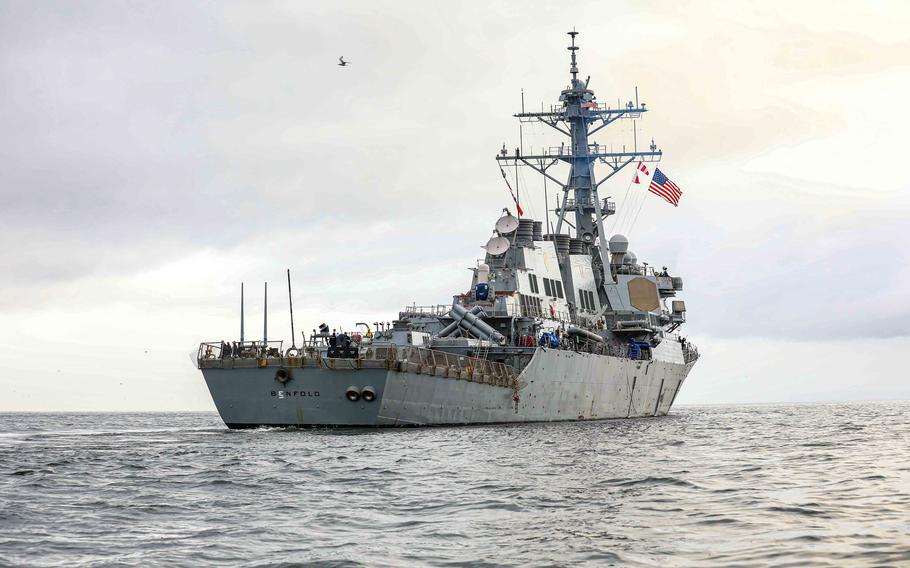
The guided-missile destroyer USS Benfold steams near Dutch Harbor, Alaska, Aug. 8, 2023. (Justin Stack/U.S. Navy)
SEOUL, South Korea — Navy destroyers from the United States, South Korea and Japan simulated their defense against a ballistic missile Tuesday in response to recent North Korean missile tests.
The USS Benfold, South Korea’s Yulgok Yi I and Japan’s JS Haguro — all equipped with the Aegis Combat System — tracked a simulated North Korean ballistic missile in international waters south of Jeju Island, a South Korean territory, South Korea’s Ministry of National Defense said in a news release Tuesday.
The drill was a response to “advancing North Korean nuclear and missile threats,” including the communist regime’s recent failed attempts to put a military satellite into orbit atop a ballistic missile, the ministry added.
“This exercise served as momentum to further improve our reaction posture and capabilities against North Korean missile threats,” South Korean navy Capt. Kim Ki Young said in the release. “We will further tighten [South Korea’s] national security based on our military’s strong response system and trilateral cooperation in the future.”
The Benfold carried out a seaborne missile-defense drill with the Yulgok Yi I and JS Atago in the Sea of Japan, or the East Sea, on April 17, four days after North Korea test-fired a solid-fuel intercontinental ballistic missile.
Separate military drills by U.S. and South Korean forces are underway throughout South Korea as part of the large-scale Ulchi Freedom Exercise. The 11-day exercise that kicked off Aug. 21 tests the allies' capabilities against North Korea's military with over 30 separate drills, according to the defense ministry.
Tuesday’s maritime drill came five days after North Korea failed to put a satellite in orbit, its second attempt since May. The North’s state-run Korean Central News Agency reported the rocket’s third stage malfunctioned and that the regime would try again in October.
North Korea has fired 17 ballistic missiles in 12 separate days of testing so far this year. It last fired two short-range ballistic missiles from Pyongyang that each flew around 340 miles before landing in the Sea of Japan.
President Joe Biden, South Korean President Yoon Suk Yeol and Japanese Prime Minister Fumio Kishida agreed to enhance their countries’ military ties in the wake of the North’s continued missile tests.
During their Aug. 18 summit at Camp David, the presidential retreat in Maryland, the three leaders agreed to share real-time warning data on North Korean missiles by the end of 2023 and regularly hold trilateral military exercises to deter North Korea.
“We are committed to pursuing enhanced ballistic missile defense cooperation to counter [North Korea’s] nuclear and missile threats,” the leaders said in a joint statement. “We reaffirm that achieving a world without nuclear weapons is a common goal for the international community, and we continue to make every effort to ensure that nuclear weapons are never used again.”
Following the summit, a KCNA report described Biden, Yoon and Kishida as a “puppet group” and accused them of destabilizing the Korean Peninsula.
Stars and Stripes reporter Yoo Kyong Chang contributed to this report.